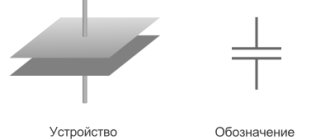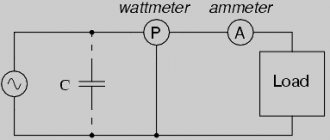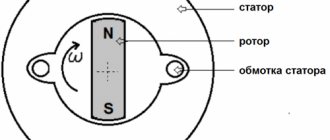Electric current (I) is the directional movement of electric charges (ions in electrolytes, conduction electrons in metals). A necessary condition for the flow of electric current is the closed circuit.
Electrical current is measured in amperes (A)
.
The derived units of current are: 1 kiloampere (kA) = 1000 A; 1 milliamp (mA) 0.001 A; 1 microampere (µA) = 0.000001 A.
A person begins to feel a current of 0.005 A passing through his body. A current greater than 0.05 A is dangerous to human life.
Electrical voltage (U)
is called the potential difference between two points in the electric field.
Unit of electrical potential difference
is volt (V). 1 V = (1 W) : (1 A).
The derived voltage units are:
1 kilovolt (kV) = 1000 V; 1 millivolt (mV) = 0.001 V; 1 microvolt (µV) = 0.00000 1 V.
Resistance of a section of an electrical circuit
is a quantity that depends on the material of the conductor, its length and cross-section.
Electrical resistance is measured in ohms (ohms). 1 Ohm = (1 V) : (1 A).
The derived units of resistance are:
1 kiloOhm (kOhm) = 1000 Ohm; 1 megaohm (MΩ) = 1,000,000 ohms; 1 milliOhm (mOhm) = 0.001 Ohm; 1 microOhm (µOhm) = 0.00000 1 Ohm.
The electrical resistance of the human body, depending on a number of conditions, ranges from 2000 to 10,000 Ohms.
Electrical resistivity (ρ)
is called the resistance of a wire with a length of 1 m and a cross-section of 1 mm2 at a temperature of 20 ° C.
The reciprocal of resistivity is called electrical conductivity (γ).
Power (P)
is a quantity that characterizes the rate at which energy is converted, or the rate at which work is done. Generator power is a quantity that characterizes the rate at which mechanical or other energy is converted into electrical energy in the generator. Consumer power is a quantity that characterizes the speed at which electrical energy is converted in individual sections of the circuit into other useful types of energy.
The SI system unit of power is the watt (W). It is equal to the power at which 1 joule of work is performed in 1 second:
Derived units of measurement of electrical power are:
1 kilowatt (kW) = 1000 W; 1 megawatt (MW) = 1000 kW = 1,000,000 W; 1 milliwatt (mW) = 0.001 W; o1i 1 horsepower (hp) = 736 W = 0.736 kW.
Units of measurement of electrical energy
are:
1 watt-second (W sec) = 1 J = (1 N) (1 m); 1 kilowatt-hour (kW h) = 3.6 106 W sec.
Example. The current consumed by an electric motor connected to a 220 V network was 10 A for 15 minutes. Determine the energy consumed by the motor. W*sec, or dividing this value by 1000 and 3600, we get energy in kilowatt-hours:
The essence of the phenomenon
Voltage is the electrical driving force that is designed to push free types of electrons from one atom to another in a certain direction. A mandatory requirement for the flow of charges is the presence of a circuit with a closed loop, which creates the conditions for them to move. If there is a break in the electrical circuit, then the process of directional movement of particles stops.
Note! It is worth noting that the unit of voltage in an electrical circuit depends on the material of the conductor, how the load is connected, and what the temperature is.
Varieties
There are two types: constant and variable. The first is in electrostatic types of circuits and those that have direct current. Variable occurs where there is sinusoidal energy. It is important that sinusoidal energy is divided into effective, instantaneous and average rectified. The unit of measurement for electric current voltage is volt.
It is also worth noting that the amount of energy between the phases is called the linear phase, and the indicator of the ground and phase current is called the phase current. A similar rule is used in all overhead lines. On the territory of the Russian Federation, the standard household electrical network is 380 volts, and the phase network is 220 volts.
Constant pressure
Constant is the difference between electrical potentials, at which the same value remains the same with polarity changes over a specific period. The main advantage of constant energy is the fact that there is no reactive power. This means that all the power that is generated by the generator is consumed by the load, excluding wire losses. Flows throughout the entire conductor cross-section.
As for the disadvantages, there is the difficulty of increasing with decreasing energy, that is, at the moment of converting it due to the design of the converters and the lack of powerful semiconductor switches. In addition, it is difficult to decouple high and low energy.
Note! Constant energy is used in electronic circuits, galvanic cells, batteries, electrolysis plants, welding tools, inverter converters and many other devices.
AC voltage
An alternating current is a current that changes in magnitude and direction periodically, but at the same time maintains its direction in an electrical circuit unchanged. It is often called sinusoidal. One direction in which energy moves is called positive, and the other is called negative. Therefore, the resulting quantity is called positive and negative. This exponent is an algebraic quantity. In answer to the question of what the unit of voltage is called, it should be noted that it is a volt. Its value is determined by direction. The maximum value is amplitude. It happens:
maximum voltage
1.3.17 maximum voltage
(maximum voltage): The maximum permissible effective voltage at the terminals of the starting capacitor between the starting point and the moment the capacitor is disconnected.
See also related terms:
3.5.13 maximum voltage (DC or RMS AC voltage ( U
m)
[(maximum rmsac or dc voltage ( U
m)]: The maximum voltage that can be applied to the connecting devices of the intrinsically hazardous circuits of the associated electrical equipment without impairing the intrinsic safety.
7.2 Maximum voltage at the lamp electrode
a) Ballasts for lamps with low-impedance electrodes
When operating in the range of standardized supply voltage values with a resistor having a resistance indicated on the characteristics sheet of the corresponding lamp in title = "Tubular fluorescent lamps for general lighting.", replacing each electrode of the lamp, the ballast must create a voltage of no more than 6.5 on each resistor In actual value.
b) Ballasts for lamps with high-resistance electrodes
When operating in the range of standardized supply voltage values with a resistor having a resistance indicated on the characteristics sheet of the corresponding lamp in title = "Tubular fluorescent lamps for general lighting.", replacing each electrode of the lamp, the ballast must create a voltage on each resistor of no more than 11.0 In actual value.
If this voltage exceeds 11.0 V, the said test must be carried out with a resistor whose resistance is derived from the rated current of the lamp indicated on the characteristics sheet of the corresponding lamp in title="Tubular fluorescent lamps for general lighting." and substituted into the formula
where In
— rated operating current of the lamp, A.
For lamps not specified in title="Tubular fluorescent lamps for general lighting.", the values assigned by the lamp manufacturer must be used.
When the ballast operates in the range of rated supply voltage values, the current through each resistor should not exceed 2.1 times the rated value In
, indicated on the characteristics sheet of the corresponding lamp in title = "Tubular fluorescent lamps for general lighting."
Measuring instruments
To measure force, a dial or analog, digital or electronic voltmeter is used. With these instruments, signal characteristics can be measured and monitored. You can also take measurements with oscilloscopes. They work due to the fact that energy is deflected by an electron beam and supplied to a device that produces an indicator of a variable value.
Voltage is a physical quantity that shows the amount of current in a circuit and equipment in volts. Current can be constant or alternating. The difference is that the first concept means that the current constantly changes its polarity and flows alternately in the network. In the second case, the current passes through the electrical circuit without interruption. Measured with a voltmeter.
In this article we will analyze in detail what voltage is, how to simply represent and measure it.
Voltage value
The electrical potential between two points on an electrical network can be determined by the work that has been done over a specific period of time. You can also take into account the amount of heat released.
If we are talking about alternating voltage, then you need to act differently. The intensity of the oscillations has the form of a sinusoidal curve. Only at the peak of amplitude can the indicator reach its maximum value. To solve problems in physics, it is customary to use an average indicator, which is also called the current indicator. The resulting value can be equated to a similar indicator of constant voltage.
The effective value is slightly less than the maximum parameter (about 1.4 times). If the network has a minimum voltage of 220 V, then the maximum will be 311 V.
These numbers are especially important when you need to choose the right capacitors, diode elements or other devices for successful installation of an electrical network.
Voltage representation
The easiest way to understand voltage is to imagine the pressure in a pipe. At higher voltage (pressure) a higher current will flow. While it is important to understand that voltage (pressure) can exist without current (flow), current cannot exist without voltage (pressure).
Voltage is often called potential difference because between any two points in a circuit there will be a difference in the potential energy of the electrons. When electrons flow through a battery, their potential energy increases, but when they flow through a light bulb, their potential energy will decrease, this energy will leave the circuit in the form of light and heat.
Take for example a regular 1.5V AA battery, there is a potential difference of 1.5V between the two terminals (+ and -).
How is voltage measured?
We measure voltage in units of "Volts", which are usually designated simply by the letter "V" on drawings and technical literature. It is often necessary to quantify the magnitude of voltage, this is done according to SI units, the most common voltage values you will see are:
- megavolt (mV)
- kilovolt (kV)
- volt (V)
- millivolt (mV)
- microvolt (µV)
Voltage is always measured at two points using a device called a voltmeter . Voltmeters are either digital or analog, with the latter being the most accurate. Voltmeters are usually built into handheld digital multimeters, as shown below, and are a common and often essential tool for any electrician or electrical engineer. You'll usually find analog voltmeters on older electrical panels such as switchboards and generators, but almost all new equipment will come with digital meters as standard.
On electrical diagrams, you will see voltmeter devices labeled with a V inside a circle , as shown below:
Voltage calculation
In electrical circuits, voltage can be calculated according to Ohm's triangle . To find voltage (V), simply multiply current (I) by resistance (R).
Voltage (V) = Current (I) * Resistance (R)
V = I *R
Example
Circuit current (I) = 10 A Circuit resistance (R) = 2 ohms
Voltage (V) = 10 A * 2 Ohm
Answer: V = 20V
Current.
Current is the speed at which a charge moves at a certain point; this value is measured in Amperes. There is also a point here that is important to understand once and for all. If we measure voltage between(!) two points, then the current always passes through(!) some point in the circuit, or through some element of the circuit. And if we talk about voltage at some point in the circuit, then we mean the voltage between this point and the ground (the potential at our point minus the ground potential, which is equal to zero).
There is one important law for currents, it is called Kirchhoff’s first law and it lies in the fact that “the sum of currents flowing into a point is equal to the sum of currents flowing out of the same point.” For a complete understanding, look at the diagram:
Here we have inflowing currents - I_1, I_2, I_3, and outflowing currents - I_4, I_5. And according to Kirchhoff’s first law, we have: I_1 + I_2 + I_3 = I_4 + I_5.
Summary
- Voltage is the force that moves electrons from one atom to another
- Voltage is also known as potential difference
- Voltage is measured in units of "volts" (V)
- Batteries increase the potential energy of electrons
- Light bulbs and other loads reduce the potential energy of electrons
- Voltage is measured using a voltmeter
- Circuit voltage can be calculated by multiplying current and resistance
Timerkaev Boris is a 68-year-old doctor of physical and mathematical sciences, professor from Russia. He is the head of the department of general physics at the Kazan National Research Technical University named after A. N. TUPOLEV - KAI
Types of voltage
Constant pressure
The voltage in the electrical network is constant when there is always a positive potential on one side and a negative potential on the other. The electric current in this case has one direction and is constant.
The voltage in a direct current circuit is defined as the potential difference at its ends.
When connecting a load to a DC circuit, it is important not to mix up the contacts, otherwise the device may fail. A classic example of a constant voltage source is batteries. DC networks are used when there is no need to transmit energy over long distances: in all types of transport - from motorcycles to spacecraft, in military equipment, electric power and telecommunications, for emergency power supply, in industry (electrolysis, smelting in electric arc furnaces, etc. .).











